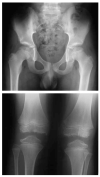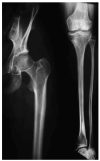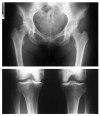Preselection of cases through expert clinical and radiological review significantly increases mutation detection rate in multiple epiphyseal dysplasia
- PMID: 17133256
- PMCID: PMC2670452
- DOI: 10.1038/sj.ejhg.5201744
Preselection of cases through expert clinical and radiological review significantly increases mutation detection rate in multiple epiphyseal dysplasia
Abstract
Skeletal dysplasias are difficult to diagnose for the nonexpert. In a previous study of patients with multiple epiphyseal dysplasia (MED), we identified cartilage oligomeric matrix protein (COMP) mutations in only 36% of cases and suspected that the low-mutation detection rate was partially due to misdiagnosis. We therefore instituted a clinical-radiographic review system, whereby all cases were evaluated by a panel of skeletal dysplasia experts (European Skeletal Dysplasia Network). Only those patients in whom the diagnosis of MED was confirmed by the panel were screened for mutations. Under this regimen the mutation detection rate increased to 81%. When clinical-radiological diagnostic criteria were relaxed the mutation rate dropped to 67%. We conclude that expert clinical-radiological review can significantly enhance mutation detection rates and should be part of any diagnostic mutation screening protocol for skeletal dysplasias.
Figures





Similar articles
-
COMP mutation screening as an aid for the clinical diagnosis and counselling of patients with a suspected diagnosis of pseudoachondroplasia or multiple epiphyseal dysplasia.Eur J Hum Genet. 2005 May;13(5):547-55. doi: 10.1038/sj.ejhg.5201374. Eur J Hum Genet. 2005. PMID: 15756302 Free PMC article. Review.
-
Multiple epiphyseal dysplasia: clinical and radiographic features, differential diagnosis and molecular basis.Best Pract Res Clin Rheumatol. 2008 Mar;22(1):19-32. doi: 10.1016/j.berh.2007.11.009. Best Pract Res Clin Rheumatol. 2008. PMID: 18328978 Review.
-
[Progress of molecular genetic research on pseudoachon-droplasia and multiple epiphyseal dysplasia].Yi Chuan. 2008 May;30(5):537-42. doi: 10.3724/sp.j.1005.2008.00537. Yi Chuan. 2008. PMID: 18487141 Review. Chinese.
-
A mutation in COL9A1 causes multiple epiphyseal dysplasia: further evidence for locus heterogeneity.Am J Hum Genet. 2001 Nov;69(5):969-80. doi: 10.1086/324023. Epub 2001 Sep 14. Am J Hum Genet. 2001. PMID: 11565064 Free PMC article.
-
Revisit of multiple epiphyseal dysplasia: ethnic difference in genotypes and comparison of radiographic features linked to the COMP and MATN3 genes.Am J Med Genet A. 2011 Nov;155A(11):2669-80. doi: 10.1002/ajmg.a.34246. Epub 2011 Sep 30. Am J Med Genet A. 2011. PMID: 21965141
Cited by
-
Recessive multiple epiphyseal dysplasia (rMED) with homozygosity for C653S mutation in the DTDST gene--phenotype, molecular diagnosis and surgical treatment of habitual dislocation of multilayered patella: case report.BMC Musculoskelet Disord. 2010 Jun 3;11:110. doi: 10.1186/1471-2474-11-110. BMC Musculoskelet Disord. 2010. PMID: 20525296 Free PMC article.
-
Case Report: Whole-exome sequencing identified two novel COMP variants causing pseudoachondroplasia.Front Endocrinol (Lausanne). 2023 Nov 23;14:1267946. doi: 10.3389/fendo.2023.1267946. eCollection 2023. Front Endocrinol (Lausanne). 2023. PMID: 38075060 Free PMC article.
-
Compendium of causative genes and their encoded proteins for common monogenic disorders.Protein Sci. 2022 Jan;31(1):75-91. doi: 10.1002/pro.4183. Epub 2021 Sep 21. Protein Sci. 2022. PMID: 34515378 Free PMC article.
-
A common pathomechanism in GMAP-210- and LBR-related diseases.JCI Insight. 2018 Dec 6;3(23):e121150. doi: 10.1172/jci.insight.121150. JCI Insight. 2018. PMID: 30518689 Free PMC article.
-
Comprehensive genetic exploration of skeletal dysplasia using targeted exome sequencing.Genet Med. 2016 Jun;18(6):563-9. doi: 10.1038/gim.2015.129. Epub 2015 Sep 24. Genet Med. 2016. PMID: 26402641
References
-
- Briggs MD, Chapman KL. Pseudoachondroplasia and multiple epiphyseal dysplasia: mutation review, molecular interactions, and genotype to phenotype correlations. Hum Mutat. 2002;19:465–478. - PubMed
-
- Rossi A, Superti-Furga A. Mutations in the diastrophic dysplasia sulfate transporter (DTDST) gene (SLC26A2): 22 novel mutations, mutation review, associated skeletal phenotypes, and diagnostic relevance. Hum Mutat. 2001;17:159–171. - PubMed
-
- Unger SL, King LM, Sobetzko D, Superti-Furga A, Cohn DH. A multiplcity of loci for multiple epiphyseal dysplasia. Am J Hum Genet. 2000;67:371.
-
- Jakkula E, Makitie O, Czarny-Ratacjzak M, et al. Mutations in the known genes are not the major cause of MED; distinctive phenotypic entities among patients with no identified mutations. Eur J Hum Genet. 2005;13:292–301. - PubMed
Publication types
MeSH terms
Substances
Grants and funding
LinkOut - more resources
Full Text Sources
Medical
Miscellaneous

